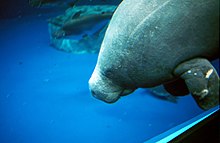African manatee
| African manatee | |
|---|---|
 |
|
| Scientific classification | |
| Kingdom: | Animalia |
| Phylum: | Chordata |
| Class: | Mammalia |
| Order: | Sirenia |
| Family: | Trichechidae |
| Genus: | Trichechus |
| Species: | T. senegalensis |
| Binomial name | |
|
Trichechus senegalensis Link, 1795 |
|
 |
|
| African manatee range | |
The African manatee (Trichechus senegalensis), also known as the West African manatee or seacow, is a species of manatee that is mostly herbivorous. African manatees inhabit much of the western region of Africa – from Senegal to Angola. Although scientists do not know a great deal about this species, they hypothesize that the African manatee is very similar to the West Indian manatee (Trichechus manatus).
The African manatee was officially declared a species under the Trichechus senegalensis taxon in 1795 by naturalist Johann Heinrich Friedrich Link. No subspecies of this taxon are known. Also, the notion that there is a significant difference between coastal manatee populations and isolated inland manatee populations has no supporting genetic evidence. The African manatee falls under the genus Trichechus with only two other species, the Amazonian manatee and the West Indian manatee, which are also sirenians.
African manatees can be found in west African regions: Angola, Benin, Cameroon, Chad, the Republic of the Congo, the Democratic Republic of the Congo, Côte d'Ivoire, Equatorial Guinea, Gabon, The Gambia, Ghana, Guinea, Guinea-Bissau, Liberia, Mali, Mauritania, Niger, Nigeria, Senegal, Sierra Leone, and Togo. Manatees are found in brackish waters to freshwater: in oceans, rivers, lakes, coastal estuaries, reservoirs, lagoons, and bays on the coast. Rarely do African manatee inhabit waters with a temperature below 18°C (64°F).
...
Wikipedia

